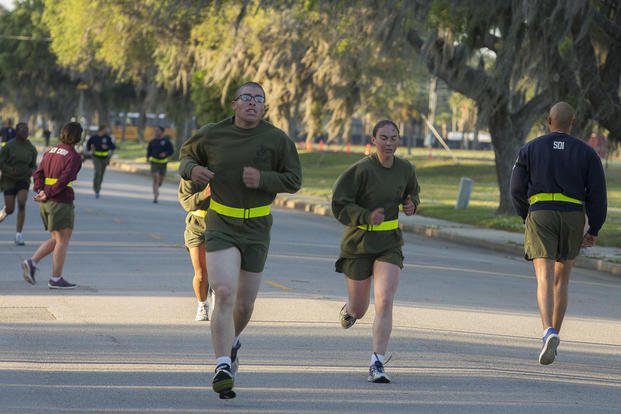The PT Progression Series is a series of answers about how to get better at pull-ups, push-ups and sit-ups for fitness testing, boot camp and police or fire academies.
Part 4 of the PT Progression Series is about adding the final segment of most fitness tests into the calisthenics workouts: Running. Learning to run at your goal pace is critical for optimal performance, and you must practice it so often that it actually becomes "muscle memory" when you run. You should be able to transition from the PT section into the running test easily and know how fast you are going by the way you are breathing, swinging your arms and striding. This takes practice, though.
You can make a pyramid out of this one or make it one tough superset, but each "rest" period between sets is a run of various distances. These types of workouts not only help your body learn how to transition from PT exercises to running, but they also can help you in simulating other exercise events, such as obstacle courses, combat conditioning courses and other job-related challenges.
Here is an all-time favorite that can progress into a workout even the toughest people cannot finish. I call this the Obstacle Course Simulation Workout Progression, but its goal is to help you with exercises for the physical fitness test (PFT). This is best if using an outdoor pull-up bar and an area to run a short distance.
Here is how it works (no rest during workout):
- Set #1: One pull-up, run 30-40 meters, two push-ups/three sit-ups, run back to the pull-up bar.
- Set #2: Two pull-ups, run 30-40 meters, four push-ups/six sit-ups, run back to the pull-up bar.
- Keep moving up the pyramid to set #10: 10 pull-ups, run 30-40 meters, 20 push-ups/30 sit-ups
Now here is where it is up to you and your fitness level. You can return and go back down the pyramid, completing the 100/200/300 total repetition challenge or try a new progression.
One-way pyramid to 20: Keep going up and see where you fail. If you continue moving up the pyramid, there is no need to return down it. The goal if you keep going past level 10 is to see whether you can reach level 20. This is a total repetition workout of 210 pull-ups, 420 push-ups and 640 sit-ups. I would recommend turning some of these sit-up sets into plank poses where each second counts as one sit-up.
Superset with running: Another option is to do a sub-max superset with running longer distances at your goal pace. For instance, you can try this if you are fairly advanced:
Repeat 10 times.
- Pull-ups 10-15
- Push-ups 25-40
- Sit-ups or plank pose/second 25-40
- Run a quarter-mile at goal pace
Running goal pace means if you are doing a quarter-mile run and you are striving to run 1.5 miles in nine minutes or two miles in 12 minutes, you have to run each quarter mile in 90 seconds.
It is recommended to do these high-volume workouts once a week. Make your other two upper-body workouts lower in volume but still focus on pace and transition from running and PT. See why the transition from PT to running is so important.
Complete PT Progression Series
- PT Progression Series #1: PT Pyramids: Do this workout every other day. No workout is good to do daily for long periods of time. It is best to do this foundation workout only three days a week.
- PT Progression #2: Superset: This is another sub max-effort foundation workout to increase the volume of your PT exercises. It is recommended to add this type of workout and replace a pyramid workout once a week so you only total these upper-body workouts only three times a week. Learn how to design a superset effectively.
- PT Progression #3: Max-Rep Set Workout: Once you have mastered the PT pyramid and the superset and can handle workouts with a volume of 100 pull-ups and 200 push-ups, then it is time to test your newfound strength. This workout will increase your muscle stamina and endurance, which is really the goal of mastering PT tests. Find out how to push your numbers even higher.
- PT Progression #4: PT/Run Workout: You can make a pyramid out of this one or make it one tough superset, but each "rest" period between sets is a run of various distances. Learn the best way to add running to the next generation of progression.
- PT Progression #5: PT and Advanced Movements Workout: Add tougher exercises into your pyramids and supersets, such as burpees, push presses, bear crawls, etc.
Stew Smith is a former Navy SEAL and fitness author certified as a Strength and Conditioning Specialist (CSCS) with the National Strength and Conditioning Association. Visit his Fitness eBook store if you're looking to start a workout program to create a healthy lifestyle. Send your fitness questions to stew@stewsmith.com.
Want to Learn More About Military Life?
Whether you're thinking of joining the military, looking for fitness and basic training tips, or keeping up with military life and benefits, Military.com has you covered. Subscribe to Military.com to have military news, updates and resources delivered directly to your inbox.



















